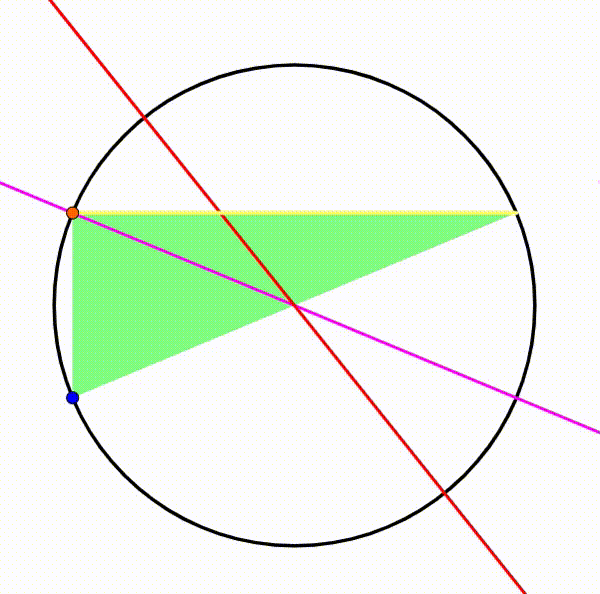Dynamic Geometry: P117
 The diagram shows a black circle. A horizontal yellow chord is drawn creating two circular segments, their respective heights
are
and
. In each circular segment, we inscribe a triangle. The triangles are both evolving so that the orange point and the blue point are moving at the same horizontal rate. The purple and red lines are the euler lines of the triangles. When the two Euler lines are perpendiculare, the distance between the blue point and the orange point can be expressed as
, where
and
are square-free coprime positive integers. Find
.
The diagram shows a black circle. A horizontal yellow chord is drawn creating two circular segments, their respective heights
are
and
. In each circular segment, we inscribe a triangle. The triangles are both evolving so that the orange point and the blue point are moving at the same horizontal rate. The purple and red lines are the euler lines of the triangles. When the two Euler lines are perpendiculare, the distance between the blue point and the orange point can be expressed as
, where
and
are square-free coprime positive integers. Find
.
The answer is 271.
This section requires Javascript.
You are seeing this because something didn't load right. We suggest you, (a) try
refreshing the page, (b) enabling javascript if it is disabled on your browser and,
finally, (c)
loading the
non-javascript version of this page
. We're sorry about the hassle.
From the compiled calculations in Dynamic Geometry: P96 Series , the radius of the circle is 6 . 5 . Let the center of the circle be O , the yellow dividing chord be A B , the upper moving and lower moving points be C and C ′ respectively.
Since the Euler line of a triangle passes through the circumcenter, the two Euler lines intersect at O , the shared circumcenter of the two triangles. From the previous problem of the series, Dynamic Geometry: P101 , we concluded that the locus of the orthocenter of the inscribed triangle is a circle with the same radius of 6 . 5 and its center 5 above the inscribing circle such that the orthocenters of the upper and lower triangles are H and H ′ respectively. where C H = C ′ H ′ = 5 .
Since the Euler line also passes through the orthocenter. O H and O H ′ are along the respective Euler lines. Let M be the midpoint of C C ′ . Since △ C O C ′ is isosceles, O M is perpendicular to C C ′ . Let ∠ C O M = C ′ O M = θ . When the Euler lines or O H and O H ′ are perpendicular to each other,
∠ H O M tan ∠ H O M O M H M 6 . 5 cos θ 6 . 5 sin θ + 5 4 1 6 9 sin 2 θ − 2 5 3 3 8 sin 2 θ ⟹ sin θ = ∠ O H ′ M = tan ∠ O H ′ M = H ′ M O M = 6 . 5 sin θ − 5 6 . 5 cos θ = 4 1 6 9 cos 2 θ = 2 6 9 = 1 3 1 2 2 6 9
The distance between the two moving points C C ′ = 2 ⋅ 6 . 5 sin θ = 2 2 6 9 . Therefore p + q = 2 6 9 + 2 = 2 7 1 .